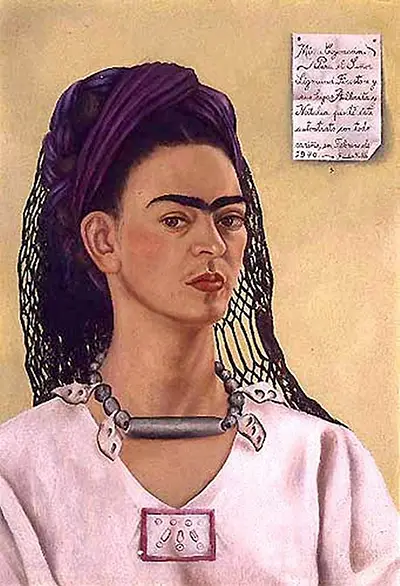Frida used oil and a 61 by 43 cm Masonite as the primary media for the painting. Frida Khalo dedicated the painting to Sigmund Firestone and his two daughters (Alberta and Natalia). She wrote in a letter, "I painted this self-portrait with affection." She also used the letter to assure Sigmund that Diego, her patron, would start working on his self-portrait as soon as he completed the murals he was working on.
The painting features a light brown background with a letter pinned at the top right corner. At the center of the painting is an image of Frida Khalo with her head slightly facing the right, so one of her ears is shown. She has a purple piece of cloth covering most of her head and hair. Her face features a bold and serious look as she faces straight ahead. Frida appears to be wearing subtle makeup, including a bit of blush and red lipstick. Her unibrow is quite prominent in the painting. She has a metallic necklace with small balls and one slightly long bar at the front of her neck. In the painting, Frida wears a pink shirt with a V-neck collar. Parts of the shirt's arms appear in the image. However, seeing that it is a portrait, it only showcases part of her shoulder. Her use of color in the painting is a signature Frida Kahlo style, which is also featured in many of her compositions.
Similar Compositions
This self portrait was the first of many by Frida Khalo. In 1940, she made another self portrait dedicated to Dr. Eloesser. In this painting, she adorns a thorn necklace with a single strain but drawing a lot of blood. The thorn necklace had become a signature for Frida as, before this, she made another self portrait featuring a large thorn necklace being held by monkeys from behind. She named this composition Self Portrait with Thorn Necklace and Hummingbird. Frida Khalo also made numerous paintings featuring herself as the heroine or the main character. They include; the Two Fridas and Tree of Hope, Remain Firm.
Conclusion
The original Self Portrait Dedicated to Sigmund Firestone is currently housed as part of the Violet Gershenson Collection in New York City, US. This painting remains to be one of the best and most critically acclaimed paintings by Frida Kahlo.

